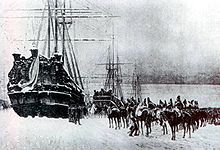Transfer of the Dutch fleet in 1795
The handover of the Dutch fleet in 1795 was an event that led to the claim in later reports, which from a French point of view was embellished, that French cavalry had conquered the Dutch fleet. This legend is based on the description by Antoine-Henri Jomini published in 1819 , which many later authors adopted.
prehistory
In the summer of 1794 the French general Jean-Charles Pichegru invaded the United Netherlands and began to conquer the country. Brussels was captured on July 10th and Antwerp on July 22nd. Winter set in early and with unusually heavy frost. The canals froze over so that the French troops could cross the many waterways without difficulty. On January 17, 1795, the French took Utrecht . On the night of January 18, the inheritance holder William V of Orange fled by ship from Haarlem to Harwich in Great Britain. The Batavian Republic was proclaimed that same night . On January 20th, the French occupied Amsterdam .
The location of the fleet
Wilhelm V had ordered the commander-in-chief of the Dutch fleet, Admiral Jan Hendrik van Kinsbergen , to anchor the fleet in Marsdiep near Den Helder . At the beginning of December 1794, the temperatures were unusually low for a week and the Wadden Sea from Den Helder to Harlingen froze over completely. This made it impossible to enter the IJsselmeer . A heavy north-west storm followed for days. Nevertheless, the majority of the fleet - 11 ships of the line , two transporters and a number of smaller units - managed to maneuver into the Nieuwediep in the lee of the island of Texel . When it finally cleared up, a high ice barrier piled up in the Marsdiep between Texel and Den Helder. Attempts to break the ice barrier with black powder were unsuccessful. The contemplated self-sinking in the event of a French attack was also not promising, since with the shallow water the French could have recovered the ship's guns without great effort. It continued to freeze and the ships were now completely enclosed in the ice.
On January 21st, Captain H. Reyntjes, the highest ranking officer of the trapped ships, received orders from the State Council of Holland and West Friesland to all naval and army units to cease all fighting against French troops through messengers from Admiral van Kinsbergen. The States General , the Dutch Parliament, shortly thereafter passed a resolution with the same content, dated January 21st.
The handover

In mid-January General Pichegru heard about the fleet trapped in the ice. He ordered the brigadier de Winter Jan Willem , to prevent the ships to the UK or in the still of the Orangemen held Zeeland entkämen. On the night of January 23, 1795, the 23-year-old commandant (battalion commander) and later Lieutenant General Louis Joseph Lahure reached the Marsdiep near Den Helder with 780 foot soldiers, 128 hussars , 39 gunners and four six-pounder bronze cannons. On the morning of January 23 he rode with some of his hussars of the 8th Hussars across the ice to the Dutch flagship , the battleship Admiraal Piet Heyn where Captain Reyntjes welcomed him to negotiate. The course of these negotiations is unknown, but it appears that an agreement was reached to keep the status quo until clear instructions were received.
Five days later, in the presence of General Winter, who had meanwhile arrived, the officers and crews of the ships, just like the crews of the Dutch ships in the port of Hellevoetsluis , swore to obey French orders not to leave their ships without French approval, and to maintain military discipline. The ships remained under the Dutch flag and did not have to be disarmed.
Remarks
- ↑ Jomini's sources are not known, but were probably one or more of the hussars involved.
Web links
- Peter Davis: French Cavalry Defeats Dutch Fleet?
- Erik Durschmied : The Weather Factor - How Nature Has Changed History. Arcade Publishing, New York 2001, ISBN 1-55970-558-2 , pp. 72-86.
literature
- Antoine-Henri Jomini : Histoire critique et militaire des guerres de la Revolution. Anselin et Pochard, Paris 1819.
- Johannes Cornelis de Jonge : Geschiedenis van het Nederlandse zeewezen. 3. Edition. Hoogstraten & Gorter, Zwolle 1869.

